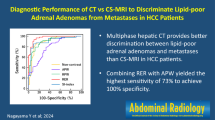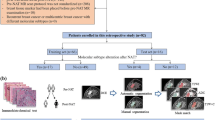Abstract
Objectives
To develop a deep learning (DL) method that can determine the Liver Imaging Reporting and Data System (LI-RADS) grading of high-risk liver lesions and distinguish hepatocellular carcinoma (HCC) from non-HCC based on multiphase CT.
Methods
This retrospective study included 1049 patients with 1082 lesions from two independent hospitals that were pathologically confirmed as HCC or non-HCC. All patients underwent a four-phase CT imaging protocol. All lesions were graded (LR 4/5/M) by radiologists and divided into an internal (n = 886) and external cohort (n = 196) based on the examination date. In the internal cohort, Swin-Transformer based on different CT protocols were trained and tested for their ability to LI-RADS grading and distinguish HCC from non-HCC, and then validated in the external cohort. We further developed a combined model with the optimal protocol and clinical information for distinguishing HCC from non-HCC.
Results
In the test and external validation cohorts, the three-phase protocol without pre-contrast showed κ values of 0.6094 and 0.4845 for LI-RADS grading, and its accuracy was 0.8371 and 0.8061, while the accuracy of the radiologist was 0.8596 and 0.8622, respectively. The AUCs in distinguishing HCC from non-HCC were 0.865 and 0.715 in the test and external validation cohorts, while those of the combined model were 0.887 and 0.808.
Conclusion
The Swin-Transformer based on three-phase CT protocol without pre-contrast could feasibly simplify LI-RADS grading and distinguish HCC from non-HCC. Furthermore, the DL model have the potential in accurately distinguishing HCC from non-HCC using imaging and highly characteristic clinical data as inputs.
Clinical relevance statement
The application of deep learning model for multiphase CT has proven to improve the clinical applicability of the Liver Imaging Reporting and Data System and provide support to optimize the management of patients with liver diseases.
Key Points
• Deep learning (DL) simplifies LI-RADS grading and helps distinguish hepatocellular carcinoma (HCC) from non-HCC.
• The Swin-Transformer based on the three-phase CT protocol without pre-contrast outperformed other CT protocols.
• The Swin-Transformer provide help in distinguishing HCC from non-HCC by using CT and characteristic clinical information as inputs.





Similar content being viewed by others
Abbreviations
- AFP:
-
Alpha-fetoprotein
- ALP:
-
Alkaline phosphatase
- ALT:
-
Alanine transaminase
- AP:
-
Arterial phase
- AST:
-
Aspartate amino transferase
- AUC:
-
Area under the ROC curve
- CECT:
-
Contrast-enhanced computed tomography
- CNNs:
-
Convolutional neural networks
- CT:
-
Computed tomography
- DICOM:
-
Digital Imaging and Communications in Medicine
- DL:
-
Deep learning
- DP:
-
Delayed phase
- HCC:
-
Hepatocellular carcinoma
- HCC-ICC:
-
Combined HCC and intrahepatic cholangiocarcinoma
- HIFU:
-
High-intensity focused ultrasound
- HU:
-
Hounsfield units
- LI-RADS:
-
Liver Imaging Reporting and Data System
- PACS:
-
The Picture Archiving and Communication System
- PLT:
-
Platelet
- Pre:
-
Pre-contrast phase
- PT:
-
Prothrombin time
- PVP:
-
Portal-venous phase
- ROC:
-
Receiver operating characteristic
- ROI:
-
Region of interest
- TACE:
-
Transarterial chemoembolization
- TBIL:
-
Total bilirubin
References
Sung H, Ferlay J, Siegel RL et al (2021) Global Cancer Statistics 2020: GLOBOCAN estimates of incidence and mortality worldwide for 36 cancers in 185 countries. CA Cancer J Clin 71:209–249. https://doi.org/10.3322/caac.21660
Marrero JA, Kulik LM, Sirlin CB et al (2018) Diagnosis, staging, and management of hepatocellular carcinoma: 2018 Practice Guidance by the American Association for the Study of Liver Diseases. Hepatology 68:723–750. https://doi.org/10.1002/hep.29913
European Association for the Study of the Liver (2018) EASL Clinical Practice Guidelines: management of hepatocellular carcinoma. J Hepatol 69:182–236. https://doi.org/10.1016/j.jhep.2018.03.019
Heimbach JK, Kulik LM, Finn RS et al (2018) AASLD guidelines for the treatment of hepatocellular carcinoma. Hepatology 67:358–380. https://doi.org/10.1002/hep.29086
Chernyak V, Fowler KJ, Kamaya A et al (2018) Liver Imaging Reporting and Data System (LI-RADS) version 2018: imaging of hepatocellular carcinoma in at-risk patients. Radiology. https://doi.org/10.1148/radiol.2018181494
Fowler KJ, Tang A, Santillan C et al (2018) Interreader reliability of LI-RADS version 2014 algorithm and imaging features for diagnosis of hepatocellular carcinoma: a large international multireader study. Radiology 286:173–185. https://doi.org/10.1148/radiol.2017170376
Ehman EC, Behr SC, Umetsu SE et al (2016) Rate of observation and inter-observer agreement for LI-RADS major features at CT and MRI in 184 pathology proven hepatocellular carcinomas. Abdom Radiol (NY) 41:963–969. https://doi.org/10.1007/s00261-015-0623-5
Peng L, Wang C, Tian G et al (2022) Analysis of CT scan images for COVID-19 pneumonia based on a deep ensemble framework with DenseNet, Swin transformer, and RegNet. Front Microbiol 13:995323. https://doi.org/10.3389/fmicb.2022.995323
Fan X, Feng X, Dong Y, Hou H (2022) COVID-19 CT image recognition algorithm based on transformer and CNN. Displays 72:102150. https://doi.org/10.1016/j.displa.2022.102150
Cao K, Deng T, Zhang C, Lu L, Li L (2022) A CNN-transformer fusion network for COVID-19 CXR image classification. PLoS One 17:e0276758. https://doi.org/10.1371/journal.pone.0276758
Yang M, He X, Xu L et al (2022) CT-based transformer model for non-invasively predicting the Fuhrman nuclear grade of clear cell renal cell carcinoma. Front Oncol 12. https://doi.org/10.3389/fonc.2022.961779
Huang Y, Si Y, Hu B et al (2022) Transformer-based factorized encoder for classification of pneumoconiosis on 3D CT images. Comput Biol Med 150:106137. https://doi.org/10.1016/j.compbiomed.2022.106137
Wu Y, Qi S, Sun Y et al (2021) A vision transformer for emphysema classification using CT images. Phys Med Biol 66:245016. https://doi.org/10.1088/1361-6560/ac3dc8
Liu Z, Lin Y, Cao Y et al (2021) Swin Transformer: hierarchical vision transformer using shifted windows. arXiv e-prints https://doi.org/10.48550/arXiv.2103.14030
Wu J, Xu Q, Shen Y et al (2022) Swin Transformer improves the IDH mutation status prediction of gliomas free of MRI-based tumor segmentation. J Clin Med 11:4625. https://doi.org/10.3390/jcm11154625
Zhao W, Chen W, Li G et al (2022) GMILT: a novel transformer network that can noninvasively predict EGFR mutation status. IEEE Trans Neural Netw Learn Syst.https://doi.org/10.1109/tnnls.2022.3190671
Ranganathan P, Pramesh CS, Aggarwal R (2017) Common pitfalls in statistical analysis: measures of agreement. Perspect Clin Res. https://doi.org/10.4103/picr.PICR_123_17
Yamashita R, Mittendorf A, Zhu Z et al (2020) Deep convolutional neural network applied to the liver imaging reporting and data system (LI-RADS) version 2014 category classification: a pilot study. Abdom Radiol (NY) 45:24–35. https://doi.org/10.1007/s00261-019-02306-7
Sheng R, Huang J, Zhang W et al (2021) A semi-automatic step-by-step expert-guided LI-RADS grading system based on gadoxetic acid-enhanced MRI. J Hepatocell Carcinoma. https://doi.org/10.2147/jhc.S316385
Wu Y, White GM, Cornelius T et al (2020) Deep learning LI-RADS grading system based on contrast enhanced multiphase MRI for differentiation between LR-3 and LR-4/LR-5 liver tumors. Ann Transl Med 8:701. https://doi.org/10.21037/atm.2019.12.151
Kamath A, Roudenko A, Hecht E et al (2019) CT/MR LI-RADS 2018: clinical implications and management recommendations. Abdom Radiol (NY) 44:1306–1322. https://doi.org/10.1007/s00261-018-1868-6
Furlan A, Marin D, Vanzulli A et al (2011) Hepatocellular carcinoma in cirrhotic patients at multidetector CT: hepatic venous phase versus delayed phase for the detection of tumour washout. Br J Radiol. https://doi.org/10.1259/bjr/18329080
Kim B, Lee JH, Kim JK et al (2018) The capsule appearance of hepatocellular carcinoma in gadoxetic acid-enhanced MR imaging: correlation with pathology and dynamic CT. Medicine (Baltimore) 97(25):e11142. https://doi.org/10.1097/MD.0000000000011142
Shi W, Kuang S, Cao S et al (2020) Deep learning assisted differentiation of hepatocellular carcinoma from focal liver lesions: choice of four-phase and three-phase CT imaging protocol. Abdom Radiol (NY) 45:2688–2697. https://doi.org/10.1007/s00261-020-02485-8
Zhou J, Wang W, Lei B et al (2020) Automatic detection and classification of focal liver lesions based on deep convolutional neural networks: a preliminary study. Front Oncol 10:581210. https://doi.org/10.3389/fonc.2020.581210
Lee H, Lee H, Hong H et al (2021) Classification of focal liver lesions in CT images using convolutional neural networks with lesion information augmented patches and synthetic data augmentation. Med Phys 48(9):5029–5046. https://doi.org/10.1002/mp.15118
Yasaka K, Akai H, Abe O, Kiryu S (2018) Deep learning with convolutional neural network for differentiation of liver masses at dynamic contrast-enhanced CT: a preliminary study. Radiology 286:887–896. https://doi.org/10.1148/radiol.2017170706
Sato M, Morimoto K, Kajihara S et al (2019) Machine-learning approach for the development of a novel predictive model for the diagnosis of hepatocellular carcinoma. Sci Rep 9:7704. https://doi.org/10.1038/s41598-019-44022-8
Nakai H, Fujimoto K, Yamashita R et al (2021) Convolutional neural network for classifying primary liver cancer based on triple-phase CT and tumor marker information: a pilot study. Jpn J Radiol 39:690–702. https://doi.org/10.1007/s11604-021-01106-8
Johnson PJ, Berhane S, Kagebayashi C et al (2015) Assessment of liver function in patients with hepatocellular carcinoma: a new evidence-based approach-the ALBI grade. J Clin Oncol 33(6):550. https://doi.org/10.1200/JCO.2014.57.9151
Yip TC, Chan HL, Wong VW et al (2017) Impact of age and gender on risk of hepatocellular carcinoma after hepatitis B surface antigen seroclearance. J Hepatol 67:902–908. https://doi.org/10.1016/j.jhep.2017.06.019
Lersritwimanmaen P, Nimanong S (2018) Hepatocellular carcinoma surveillance: benefit of serum alfa-fetoprotein in real-world practice. Euroasian J Hepatogastroenterol 8:83. https://doi.org/10.5005/jp-journals-10018-1268
Tahata Y, Sakamori R, Yamada R et al (2022) Risk of hepatocellular carcinoma after sustained virologic response in hepatitis C virus patients without advanced liver fibrosis. Hepatol Res 52:824–832. https://doi.org/10.1111/hepr.13806
Smucny J, Shi G, Lesh TA, Carter CS, Davidson I (2022) Data augmentation with Mixup: enhancing performance of a functional neuroimaging-based prognostic deep learning classifier in recent onset psychosis. Neuroimage Clin 36:103214. https://doi.org/10.1016/j.nicl.2022.103214
Acknowledgements
The authors would like to thank Drs. Yudong Wang, Qianrui Fan, Jiangfen Wu, and Master Weidao Chen (all from Institute of Research, InferVision, Ocean International Center, Chaoyang District, Beijing 100025, China) who provided technical support for the model construction of this study.
Funding
This study has received funding by Chongqing medical scientific research project (Joint project of Chongqing Health Commission and Science and Technology Bureau) (Grant No. 2022ZDXM026).
Author information
Authors and Affiliations
Corresponding authors
Ethics declarations
Guarantor
The scientific guarantors of this publication are Dajing Guo.
Conflict of interest
The authors of this manuscript declare no relationships with any companies, whose products or services may be related to the subject matter of the article.
Statistics and biometry
No complex statistical methods were necessary for this paper.
Informed consent
Written informed consent was waived by the Institutional Review Board.
Ethical approval
Institutional Review Board approval was obtained from the Second Affiliated Hospital of Chongqing Medical University and the First Affiliated Hospital of Army Military Medical University.
Methodology
-
retrospective
-
diagnostic study
-
multicenter study
Additional information
Publisher's note
Springer Nature remains neutral with regard to jurisdictional claims in published maps and institutional affiliations.
Yang Xu and Chaoyang Zhou are joint first authors.
Supplementary Information
Below is the link to the electronic supplementary material.
Rights and permissions
Springer Nature or its licensor (e.g. a society or other partner) holds exclusive rights to this article under a publishing agreement with the author(s) or other rightsholder(s); author self-archiving of the accepted manuscript version of this article is solely governed by the terms of such publishing agreement and applicable law.
About this article
Cite this article
Xu, Y., Zhou, C., He, X. et al. Deep learning–assisted LI-RADS grading and distinguishing hepatocellular carcinoma (HCC) from non-HCC based on multiphase CT: a two-center study. Eur Radiol 33, 8879–8888 (2023). https://doi.org/10.1007/s00330-023-09857-w
Received:
Revised:
Accepted:
Published:
Issue Date:
DOI: https://doi.org/10.1007/s00330-023-09857-w




